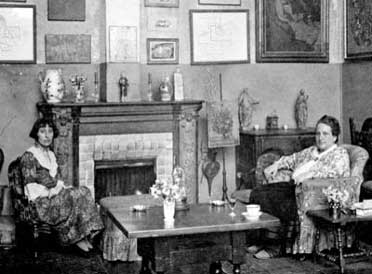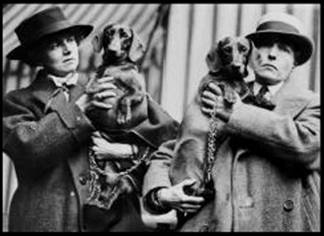Difference between revisions of "Lesbians Between the World Wars"
| Line 1: | Line 1: | ||
| − | Section by Kiara M. Vigil | + | Section by Kiara M. Vigil |
| + | |||
| + | {{Protected}} | ||
Society and politics in the United States between World War I and World War II can be characterized in a number of important ways: rapid economic growth and crisis, industrialization -- urban sprawl leading to revolutions in transportation increasing the flow of commerce while oppression of immigrant groups is commonplace, and factories turn out poverty as well as products. Women and men’s roles in society shift as skirt hems rise and the clash between the sacred and the secular produces new avenues for understanding womanhood and manhood outside of religion and under the guise of science. Political clashes also marked this period, when journalists fought with newspapers, the public sphere called for social reforms amidst opportunistic aims of private enterprise, and the United States Government and military prepared for an end to isolationism in an increasingly global view of their place in the world. Where in all of these changes and clashes did lesbians situate themselves? Where did they concretize their identities? Where did they find spaces of rejection or spaces of belonging? How might the sacred – secular debate have improved the lots of some men and women in America, and not others? What role might class have played in shaping one’s identity along gender and sexuality lines? | Society and politics in the United States between World War I and World War II can be characterized in a number of important ways: rapid economic growth and crisis, industrialization -- urban sprawl leading to revolutions in transportation increasing the flow of commerce while oppression of immigrant groups is commonplace, and factories turn out poverty as well as products. Women and men’s roles in society shift as skirt hems rise and the clash between the sacred and the secular produces new avenues for understanding womanhood and manhood outside of religion and under the guise of science. Political clashes also marked this period, when journalists fought with newspapers, the public sphere called for social reforms amidst opportunistic aims of private enterprise, and the United States Government and military prepared for an end to isolationism in an increasingly global view of their place in the world. Where in all of these changes and clashes did lesbians situate themselves? Where did they concretize their identities? Where did they find spaces of rejection or spaces of belonging? How might the sacred – secular debate have improved the lots of some men and women in America, and not others? What role might class have played in shaping one’s identity along gender and sexuality lines? | ||
Revision as of 13:27, 21 July 2008
Section by Kiara M. Vigil
Society and politics in the United States between World War I and World War II can be characterized in a number of important ways: rapid economic growth and crisis, industrialization -- urban sprawl leading to revolutions in transportation increasing the flow of commerce while oppression of immigrant groups is commonplace, and factories turn out poverty as well as products. Women and men’s roles in society shift as skirt hems rise and the clash between the sacred and the secular produces new avenues for understanding womanhood and manhood outside of religion and under the guise of science. Political clashes also marked this period, when journalists fought with newspapers, the public sphere called for social reforms amidst opportunistic aims of private enterprise, and the United States Government and military prepared for an end to isolationism in an increasingly global view of their place in the world. Where in all of these changes and clashes did lesbians situate themselves? Where did they concretize their identities? Where did they find spaces of rejection or spaces of belonging? How might the sacred – secular debate have improved the lots of some men and women in America, and not others? What role might class have played in shaping one’s identity along gender and sexuality lines?
Sexuality

These questions were answered by psychologists, sexologists, writers, and everyday people alike; from 1920 to 1945 there existed a growing awareness in the public arena of the “sexual invert” and the “love that dare not speak its’ name” that gained discursive power also in the private rooms of homes where women began to find or name their sexual identities in new ways. Not all of these women (like Alice Toklas & Gertrude Stein pictured right) may have referred to themselves using the term we so commonly and easily use today: lesbian, but whether named or not, the awareness was there, the subject position established, homosexual men and women were perhaps not “out of the closet” as many chronologies of “gay” history describe the post-WWII era, but they were certainly aware of how society was starting to categorize sexuality and gender in terms that either portrayed them, frightened them, oppressed them, or liberated them.
Gender Identity
What follows this website’s narrative section on “the years between the wars” is an annotated bibliography of primary and secondary sources that strive to articulate this time period from the vantage point of the lesbian, giving herstory not one, but many voices, situated in not one, but many places. This diversity of voice and space is testimony to the complexity of “lesbian” identity and history, and contributes to the larger narrative of American history by asserting that whether silenced or forgotten, we are now in a present moment capable of demonstrating the extent to which “homo-erotically inclined” women of the past can be studied as contributors to history. What is crucial in this pursuit is to remember the problematics involved in using terminology that could fix an identity improperly or could accidentally essentialize a subject position; throughout this narrative the use of “lesbian” denotes a current of thinking prevalent today in scholarship seeking to write a history that has for so long remained hidden. Thus, it is with this awareness that stories here do invoke the term “lesbian” for the purpose of: clarity and consistency, but not without acknowledging the social constructedness of this identity marker.
Two key events frame this period of Lesbian History. On the far end the events of World War II contributed to the development of new gender roles and different understandings of sexuality. Fewer than twenty years earlier, a new narrative emerged that dramatically introduced the term “sexual invert” into public and private spaces in ways that some found obscene and others found illuminating. From outside of America came the novel that brought lesbian identity into the parlors and courtrooms of Europe and the United States. Radclyffe Halls’

instrumental text The Well of Loneliness was published in 1929 and prompted a firestorm of criticism about the lesbian content of the story. Yet, writerly communities inside and outside of America came to support Hall’s right to write. Indeed this British author, story, and novel situate the central character of Stephen as a woman who finds through the reading of her father’s sexologist books that she is a “sexual invert.” Her biology is central to her characterization and the plot. But, what perhaps made this novel so scandalous at the time was that Stephen came to understand and embrace her identity, finding that she indeed loved and wanted relationships of a romantic nature not with men, but only with women. Interestingly, also, is although Stephen struggles with personal relationships to her mother she is very close to her father, then wins and loses her female lover in this story; in the end, she survives. Her sexual identity was described and understood by many at the time to be a form of pathology, yet it remains intact throughout the novel. Did the British obscenity charges and the American courts that tried to get this novel banned object only to the lesbian content? Or, perhaps did they fear that because Stephen is depicted as the central character, the subject and not the object of the novel’s focus, who fails to disintegrate into nothingness at the end by valiantly giving her female lover over to a man, ultimately, survives?
The lesbian as real perhaps was the biggest obscenity of them all. This novel was and continues to be widely circulated and widely read. It sparked a number of discussions and controversies to be sure, but it also inspired other writers to follow suit and (some more openly than others) wrote their own stories of queer-central characters. This novel is but one of the many events that set the stage for understanding the importance of lesbian history between World War I and World War II, indeed there are many other stories embedded in this period that redraw how to conceive of American history in terms of gender and sexuality.
The 1920s marked a period of rapid change for lesbians. With the onset of World War II, many lesbians entered factories or the military to further involve themselves in pursuits that were beyond the traditional sphere of domesticity and the private realms of home-life. Still, many “homo-erotically inclined women” could not or did not live in urban areas, near factories, or take part in new avenues allowing for the recognition and even celebration of an emergent lesbian identity. Some women lived in rural areas of South Dakota or Utah, and some were part of an upper class society abroad, like the Paris Avant-garde where lesbianism was more than tolerated. What this historical period allows us to uncover is how the emergence into public and private lexicons of terms like: sexual invert, coined by sexologists studying homosexuality (brought into increased usage through novels like Hall’s) further strengthened pre-existing murmurs of lesbianism. Whether in the bars of Buffalo or same-sex educational institutions like Wellesley College, women who loved women had key words to identify who and what they were, and more than that, we now have evidence, from the sources that follow, to demonstrate the diversity of experiences that tell a uniquely Lesbian History.
References